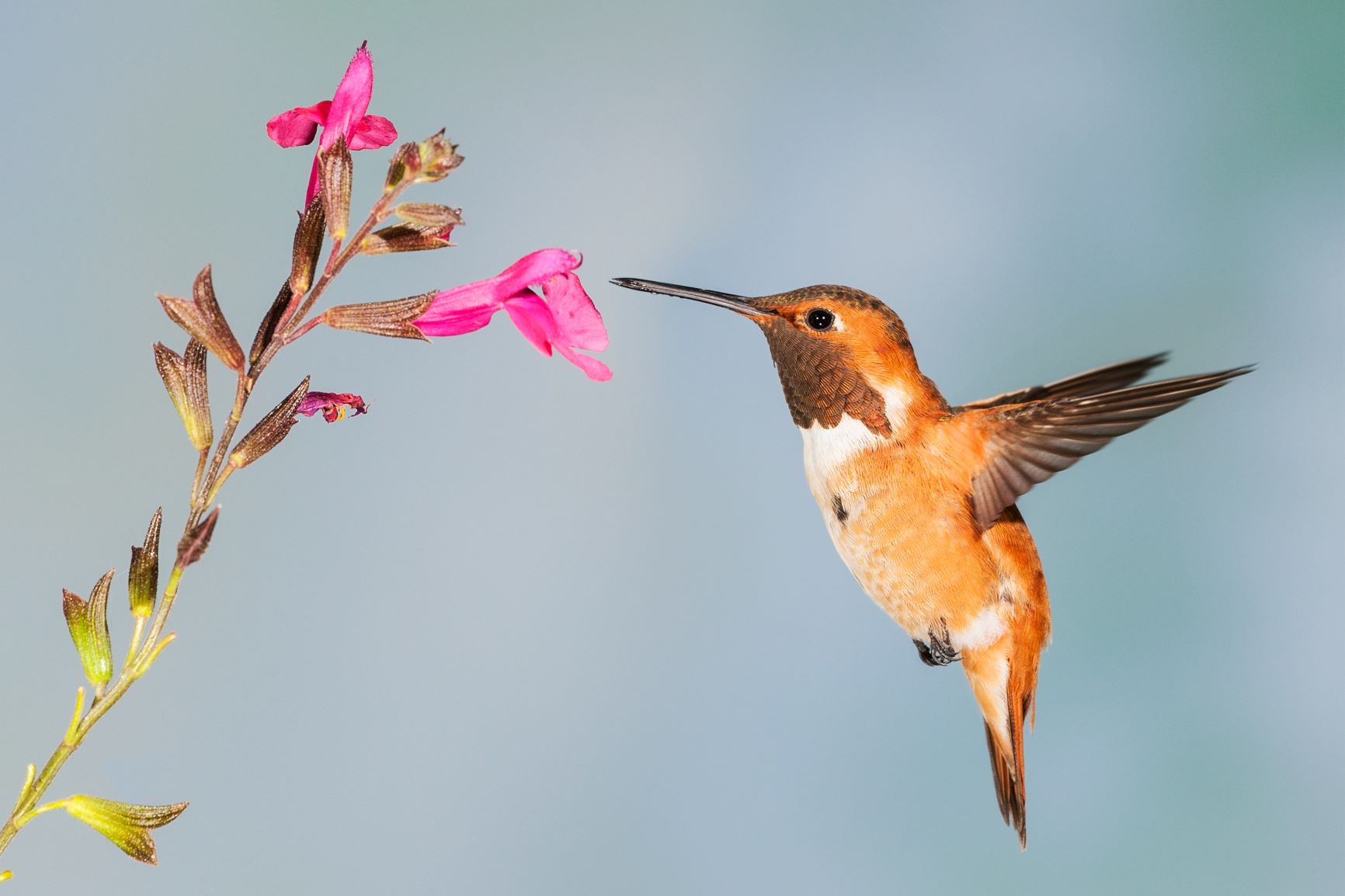Written by Sean, Little Green Guards® C.S.I.
After learning about the amazing tardigrades, I investigated another biological wonder – hummingbirds. I am interested in hummingbirds because I read that they are the smallest birds in the world and have the highest metabolism of any homeotherm relative to their body size1. Hummingbirds get their energy mainly by consuming flower nectar2. Because hummingbirds can only forage during the day, they must spend all those hours feeding. At night, hummingbirds go into torpor to conserve energy. During torpor, they reduce their metabolism by as much as 95%3.
In this project I studied the daily feeding patterns of two hummingbird species that live in southern California: Anna’s hummingbird (Calypte anna) and Allen’s hummingbird (Selasphorous sasin). I collected the information by watching a live cam located at Studio City, California4. The camera is fixed on five feeders containing artificial nectar. My hypothesis was that, due to their high metabolism, hummingbirds would need to feed throughout the day to obtain a steady stream of calories. In addition, I thought I would see more individuals at the feeders in the early morning and late afternoon because the hummingbirds would need to consume as many calories as possible after waking up and before sleeping at night.

My observations spanned from June 22 to 29, 2020 over a total of 8 days. Between 05:00 and 21:00 I noted the time when the first hummingbird(s) arrived at the feeders in the morning and when the last individual(s) left at night. I also counted the number of individuals by species every hour on the hour. If I could not identify the species, I recorded the individual(s) as unknown. I compiled my dataset using a MS Excel worksheet. Afterwards, I determined the hourly averages of individuals per species and the ratio of Anna’s and Allen’s using the feeders. For each day I also compared the hummingbirds’ first and last feeding times to the times of sunrise and sunset at the location5.
For comparative purposes, my mentor, Dr. Andy Phillips, compiled a second data set. His data consisted of the total count of hummingbird individuals taken at 15-minute intervals from June 25 to 29, 2020. He also entered his data into MS Excel and calculated hourly averages of individuals.
Here are our major findings:
- The hummingbirds were active for more than 15 hours a day, and their daily feeding schedule is highly synchronized. They first arrived at the feeders as early as 05:21 and ended their feeding as late as 20:32. They were drinking nectar 17 to 23 minutes before sunrise and after sunset, suggesting that their activity is restricted by the amount of light available.
- Their daily feeding patterns confirmed my hypothesis. Individual counts were the highest early in the morning (before 10:00) and late in the afternoon (after 18:00). At midday the number of individuals at the feeders greatly decreased. I suspect that during this period, the hummingbirds were foraging on flower nectars and insects, which means that they are using the feeders as a reliable, supplemental food source to quickly fuel up after waking up and before going to sleep.
- I observed a male hooded oriole (Icterus cucullatus) at the feeders on several occasions. During these times most of the hummingbirds left and did not return until after the oriole was gone. My counts were much lower as a result.

- Dr. Phillips’ hourly averages are generally higher than mine. In fact, the maximum number of hummingbirds he recorded was 23 but mine was 11. These differences are related to our data recording methods with shorter intervals more accurately reflecting the number of hummingbirds at the feeders per hour.

- 45% of the hummingbirds that visited the feeders were Anna’s, and 55% were Allen’s. Even though Anna’s are slightly larger than Allen’s, these two species seemed to be tolerant of one another. Because hummingbirds are known to guard a nectar resource2, I did observe extreme aggression at the feeders where two opponents repeatedly attacked one another.
Hummingbirds play an important role in our ecosystem by providing pollination services to their host plants2. Without hummingbirds those plants would have difficulty to reproduce and eventually both the hosts and the consumers could become extinct. Because so many plants depend on hummingbirds for pollination, biologists refer to hummingbirds as keystone species6.

Although it is very interesting to watch hummingbirds at feeders we must be careful and not have the birds become too dependent on the artificial nectar. If you do set up feeders, it is important to space them apart so the individuals will be less likely to fight. Also, be patient and wait a week or two because hummingbirds will need to find the feeders. Keeping the feeders clean is essential7, so they will continue to return. The USDA has produced a simple guide to help people create hummingbird-friendly gardens by planting native flowering plants8. In urban and suburban areas these gardens can be welcome oases to resident and migratory hummingbirds as well as other pollinator species.
Sources:
- Smith, R. 2015. Hummingbirds for Kids. Amazon Amazing Animal Books for Young Readers. Mendon Cottage Books.
- https://animaldiversity.org/accounts/Trochilidae/
- https://www.fws.gov/nwrs/threecolumn.aspx?id=2147491782
- https://www.youtube.com/watch?v=pXe8MpU7uzk
- http://time.unitarium.com/sunrise/9077
- https://www.desertmuseum.org/pollination/hummingbirds.php
- https://www.youtube.com/watch?v=d4IimZtzI9c
- https://www.fs.fed.us/wildflowers/pollinators/documents/AttractingHummingbirdsFS-1046April2015.pdf

Sean is an 8th grade student in Los Angeles County.

2 thoughts on “So Tiny but So Mighty: An Investigation on the Hummingbirds”
Sean, what a fascinating report, and so beautifully compiled and reported. Thank you! Your findings are interesting and helpful to me. I love hummingbirds and I’ll incorporate your recommendations.
Thanks for reading my blog, I am really glad you liked it and hope you find my recommendations useful. – Sean
Comments are closed.